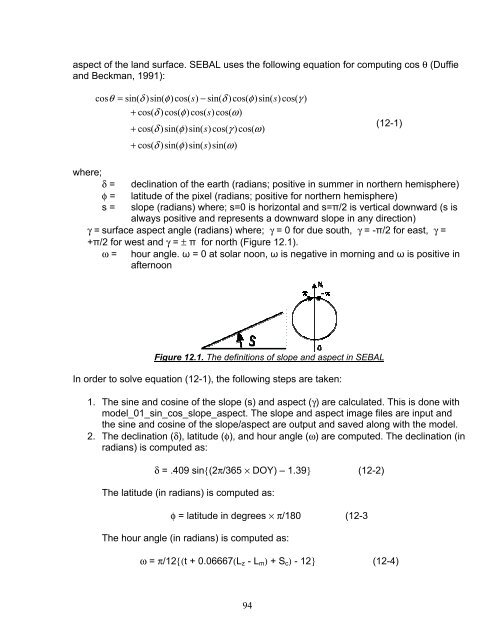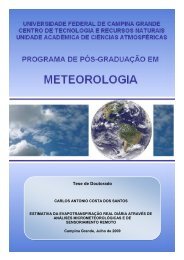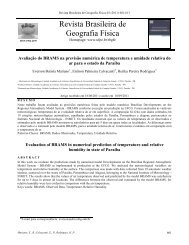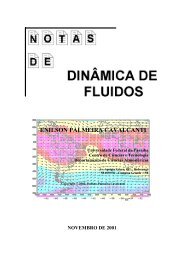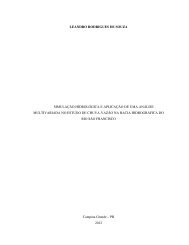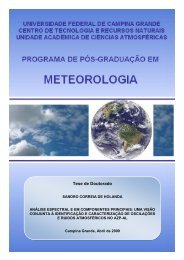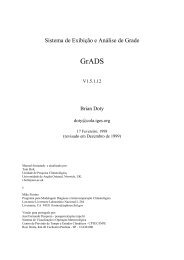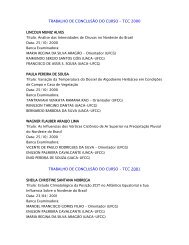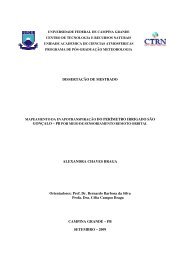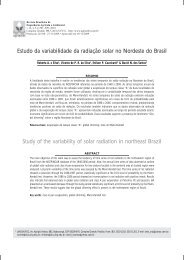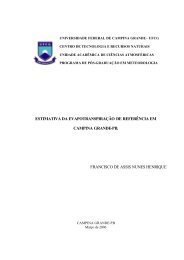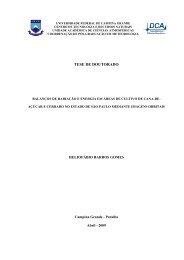aspect of the land surface. <strong>SEBAL</strong> uses the following equation for computing cos θ (Duffieand Beckman, 1991):cosθ= sin( δ )sin( φ)cos(s)− sin( δ )cos( φ)sin(s)cos(γ )+ cos( δ )cos( φ)cos(s)cos(ω)+ cos( δ )sin( φ)sin(s)cos(γ )cos( ω)+ cos( δ )sin( φ)sin(s)sin(ω)(12-1)where;δ = declination of the earth (radians; positive in summer in northern hemisphere)φ = latitude of the pixel (radians; positive for northern hemisphere)s = slope (radians) where; s=0 is horizontal and s=π/2 is vertical downward (s isalways positive and represents a downward slope in any direction)γ = surface aspect angle (radians) where; γ = 0 for due south, γ = -π/2 for east, γ =+π/2 for west and γ = ± π for north (Figure 12.1).ω = hour angle. ω = 0 at solar noon, ω is negative in morning and ω is positive inafternoonFigure 12.1. The definitions of slope and aspect in <strong>SEBAL</strong>In order to solve equation (12-1), the following steps are taken:1. The sine and cosine of the slope (s) and aspect (γ) are calculated. This is done withmodel_01_sin_cos_slope_aspect. The slope and aspect image files are input andthe sine and cosine of the slope/aspect are output and saved along with the model.2. The declination (δ), latitude (φ), and hour angle (ω) are computed. The declination (inradians) is computed as:δ = .409 sin{(2π/365 × DOY) – 1.39} (12-2)The latitude (in radians) is computed as:φ = latitude in degrees × π/180 (12-3The hour angle (in radians) is computed as:ω = π/12{(t + 0.06667(L z - L m ) + S c ) - 12} (12-4)94
where; t is the standard clock time for the satellite overpass time (hours; i.e. for14:30, t = 14.5), L z is the longitude of the center of the local time zone (degrees westof Greenwich; i.e., L z = 75, 90, 105, and 120 0 for the Eastern, Central, RockyMountain, and Pacific time zones respectively), L m is the longitude of the center ofthe satellite image (degrees west of Greenwich), and S c is a seasonal correction forsolar time (hours).The seasonal correction for solar time is computed as:S c = 0.1645 sin(2b) – 0.1255 cos(b) – 0.025 sin(b) (12-5)b = 2π(DOY – 81)/364 (12-6)3. Import and run model_02_cos_theta. Inputs are the sine and cosine of theslope/aspect, the declination, the latitude, and the hour angle. The output file for thecosine of the incidence angle is saved along with the model. In model_02, an initialvalue for cos θ is computed and is then divided by the cosine of the slope to correctit to a horizontal equivalent. This assures that all of the energy fluxes computed by<strong>SEBAL</strong> will be analyzed on a horizontal equivalent basis.D. ReflectivityIn the model for reflectivity, the input of cos θ is a file rather than a constant.E. TransmissivityThe transmissivity is no longer a constant but varies for each pixel as a function of theelevation. It is computed with the DEM subset image as the input.F. Surface AlbedoThe surface albedo is computed using the transmissivity file as input.G. Incoming Shortwave RadiationThe incoming shortwave radiation (R S↓ ) is computed for each pixel since cos θ is nowvariable for each pixel.H. Surface TemperatureGenerally, air temperature decreases 6.5 o C for each 1 km elevation increase under neutralstability conditions. Since surface temperatures are in strong equili<strong>br</strong>ium with airtemperature, one can usually observe similar decreases in surface temperature.During the prediction of the near surface temperature difference (dT), <strong>SEBAL</strong> assumes alinear relationship between dT and the surface temperature (T s ). The surface temperature,however, needs to be adjusted to a common reference elevation for accurate prediction ofdT. Otherwise, high elevations that appear to be “cool” may be misinterpreted as havinghigh ET. Therefore, in the Mountain Model, a “lapsed” (artificial) surface temperature mapis created for purposes of computing dT by assuming that the rate of decrease in surfacetemperature due to elevation increase is the same as that for a typical air profile. The95
- Page 1 and 2:
SEBALSurface Energy Balance Algorit
- Page 3 and 4:
6. Tables for surface albedo comput
- Page 5 and 6:
δ declination of the earth radians
- Page 7 and 8:
INTRODUCTION1. BACKGROUNDLand manag
- Page 9 and 10:
THE THEORETICAL BASIS OF SEBAL1. OV
- Page 11 and 12:
The surface emissivity is the ratio
- Page 13 and 14:
• Reference evapotranspiration, E
- Page 15 and 16:
Figure 3. Flow Chart of the Net Sur
- Page 17 and 18:
2. The reflectivity for each band (
- Page 19 and 20:
and ET are specified for the two ex
- Page 21 and 22:
To complete step 2, model F06_surfa
- Page 23 and 24:
D. Choosing the “Hot” and “Co
- Page 25 and 26:
irrigated crops near Kimberly, Idah
- Page 27 and 28:
where; u * is the friction velocity
- Page 29 and 30:
Weather stationu, z x, z om, u *H f
- Page 31 and 32:
Note: An alternative method used by
- Page 33 and 34:
where;⎛ 2 ⎞⎜1+ x(0.1m)Ψ = 2
- Page 35 and 36:
where; ET inst is the instantaneous
- Page 37 and 38:
Figure 6 shows an example of a dail
- Page 39 and 40:
1. If there is some cloud cover in
- Page 41 and 42:
• For all other formats (includin
- Page 43 and 44: On the main page, select Type in Pa
- Page 45 and 46: These values for z om can vary by r
- Page 47 and 48: Appendix 3Reference Evapotranspirat
- Page 49 and 50: and click on “Open”3. Provide t
- Page 51 and 52: 5. Describe weather station and wea
- Page 53 and 54: 8. Save the output file using a nam
- Page 55 and 56: 4. Go to the Viewer tool and view t
- Page 57 and 58: Appendix 5Time Issues Around Weathe
- Page 59 and 60: 2. What time interval does the data
- Page 61 and 62: The wind speed is 3.4 m/s for the 1
- Page 63 and 64: Table 6.3. ESUN λ for Landsat 5 TM
- Page 65 and 66: Table 6.6. Typical albedo values.Fr
- Page 67 and 68: 4. Make a first guess for T cold by
- Page 69 and 70: Fig.3. P40/R30, Landsat 7 ETM+ 4/8/
- Page 71 and 72: Fig.5. P40/R30, Landsat 7 ETM+ 4/8/
- Page 73 and 74: We open the image or subset image a
- Page 75 and 76: Now, we look at the northwest area
- Page 77 and 78: (2) The regional weather or soil co
- Page 79 and 80: We conclude that this “heat islan
- Page 81 and 82: Part 1: using the manual iteration
- Page 83 and 84: Part 2: Using the automatic iterati
- Page 85 and 86: Appendix 9SAVI and LAI for Southern
- Page 87 and 88: equation for G. The following are e
- Page 89 and 90: and for 24-hours:Gwater = 0.9 Rn -
- Page 91 and 92: The Stability of the AtmosphereAppe
- Page 93: Appendix 12The SEBAL Mountain Model
- Page 97: N. Momentum Roughness LengthThe mom


